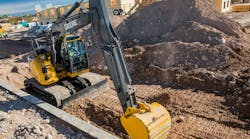We cover safety in CE, equipment manufacturers dedicate major resources to safety, and many contractors and fleet managers tell us they’re dedicated to safety all day, every day.
Yet accidents and fatalities keep happening at an alarming rate.
I know job sites can change rapidly, and despite best efforts objects fall, or plans and attention spans fail, and people and machinery pop up in places they weren’t just seconds earlier. But one of the biggest head-scratchers is the continued striking of underground utilities.
Utilities that someone, somewhere—someone very accessible—knows the location of or can quickly find with a site visit.
The Common Ground Alliance estimates an underground utility line is damaged once every six minutes nationwide because someone decided to dig without first calling the 811 utility locating service. It's more than the inconvenience of a tony neighborhood’s cable TV or Internet failing. It’s “gas line go boom” and a call to the coroner.
So we’ll hammer it home again, even though it’s not the Alliance’s National Safe Digging Month (April). Every month needs to be a safe digging month...call 811 before you dig.
Most locate crews will arrive to mark your site with paint or flags within a few days.
And let’s not forget about no-dig utility installations, the underground magic that happens with HDDs. HDD operators and crews still have to “know what’s below,” and a whole lot more. Here are some HDD safety tips from Ditch Witch senior HDD product manager Seth Matthesen, who says the most serious hazards associated with HDD include:
- Utility damage. “Calling 811 is only the first step in a long process of verifying utilities; use soft excavation, such as vacuum excavators, to expose utilities and to watch crossings. Also, use the electric strike system provided on the drill,” he says.
- Rotating drill pipe. “Do not approach rotating drill pipe.”
- Rotating tools/backstreamers at the exit pit. “Use the lockout device provided with the drill or use a lockout procedure so the exit pit crew has control to lock out the drill string before approaching.”
- Rotating product. “Stay away from any product being installed and ensure swivels are operating properly and that there are no kinks in connections.”
- Thrown pipe wrenches. “Never use pipe wrenches on the drill string. Always use the proper tools provided with your drill to change out tooling.”
- Changing pipe boxes and manually adding pipe. “Be sure to refer to the operator’s manual for proper procedures on how to change and manually add pipe.”
For more on HDDs, look for the Buying File in the August issue of Construction Equipment.
In the meantime, here’s wishing you happy and safe digging—no matter how you get it done.





